Abstract
The homology of angiogenin and pancreatic RNase A provides a compelling reason to systematically compare the characteristics of the two proteins using the chemical modification approaches that proved essential to understanding the action of RNase. Reagents specific for histidine, lysine, and arginine markedly decrease the ribonucleolytic activity of angiogenin, much as has been observed for RNase A. Activity is abolished by reduction of the disulfide bonds and is restored by reoxidation. Methionine, tyrosine, and carboxyl group reagents have no significant effect. From the point of view of reactivity, the histidine and lysine residues in angiogenin are severalfold less susceptible to modification than those in RNase A. Arginine reagents, on the other hand, inactivate angiogenin considerably faster than RNase A. Considering specificity, bromoacetate inactivates angiogenin at pH 5.5 by modifying 1.5 histidines, but lysine and arginine reagents are less specific. Thus, 3.8 and 6.3 residues, respectively, are modified by 1-fluoro-2,4-dinitrobenzene and by formaldehyde plus cyanoborohydride, under conditions where activity decreases by approximately 80% in both cases. With phenylglyoxal, 6.7 arginines are lost when there is 92% inactivation. Poly(G) prevents inactivation by lysine and arginine reagents, and phosphate protects against the effects of lysine modification. Thus, the functional consequences of these modifications likely reflect the loss of critical residues rather than general conformational effects.
Full text
PDF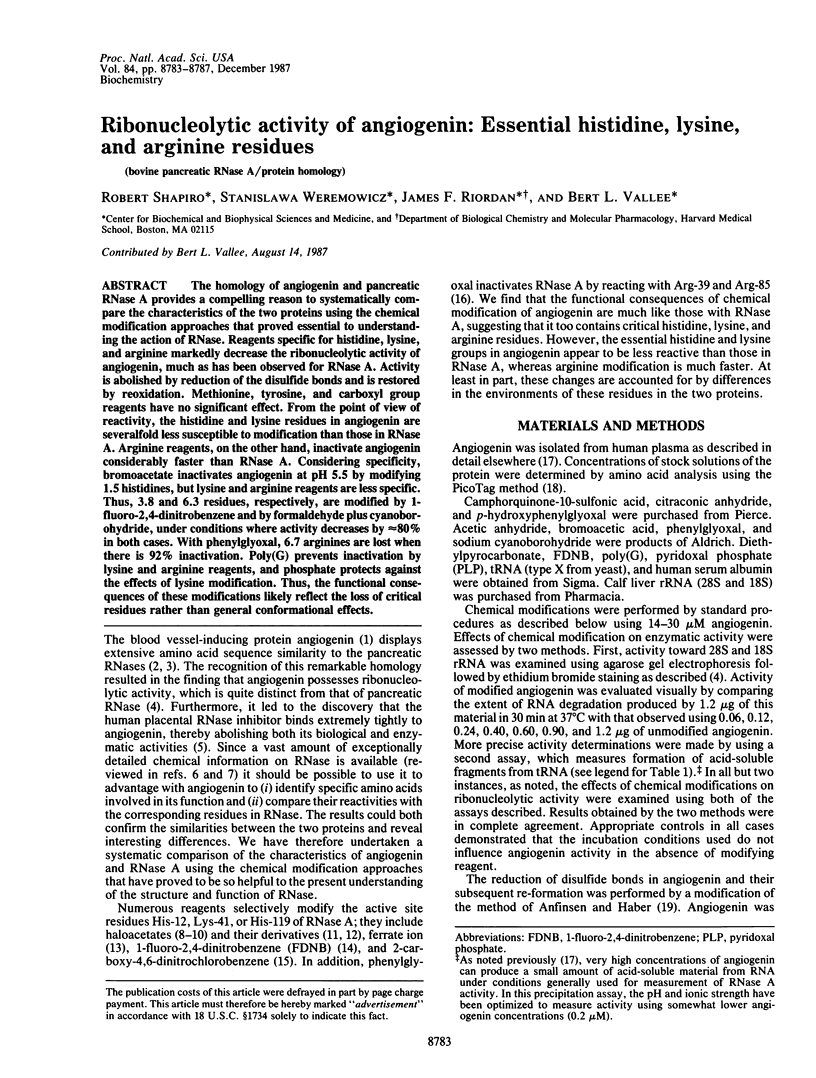
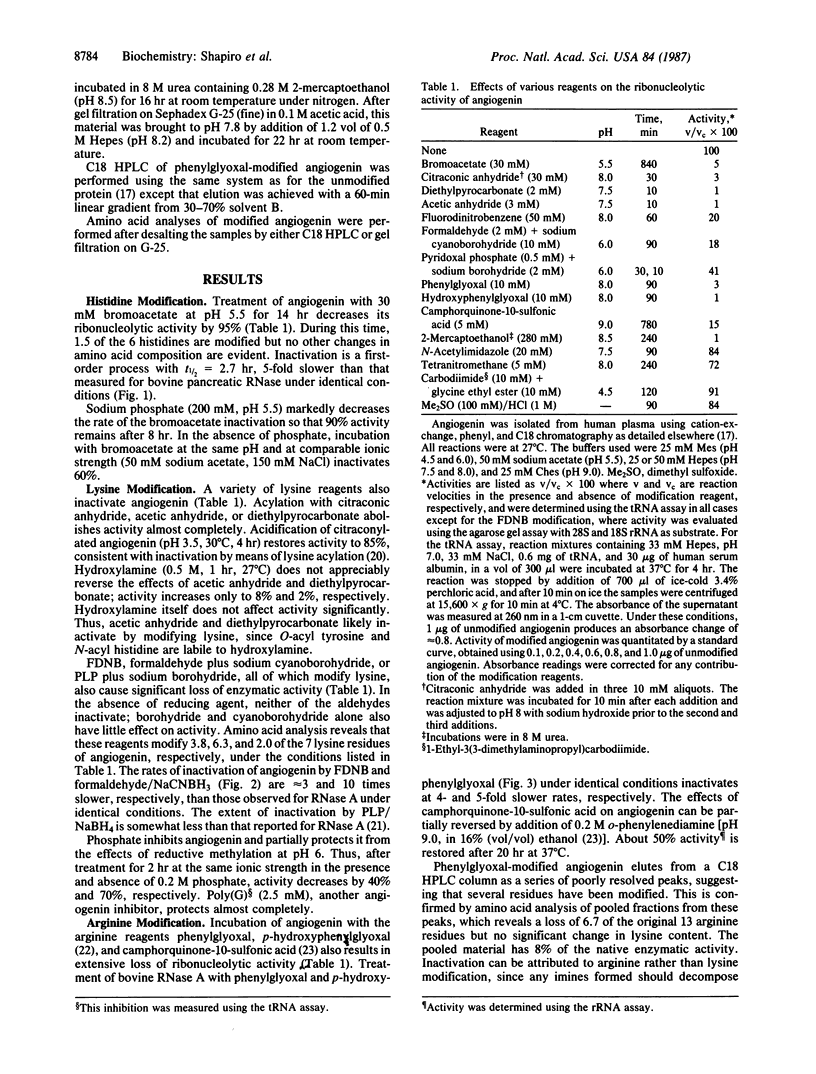
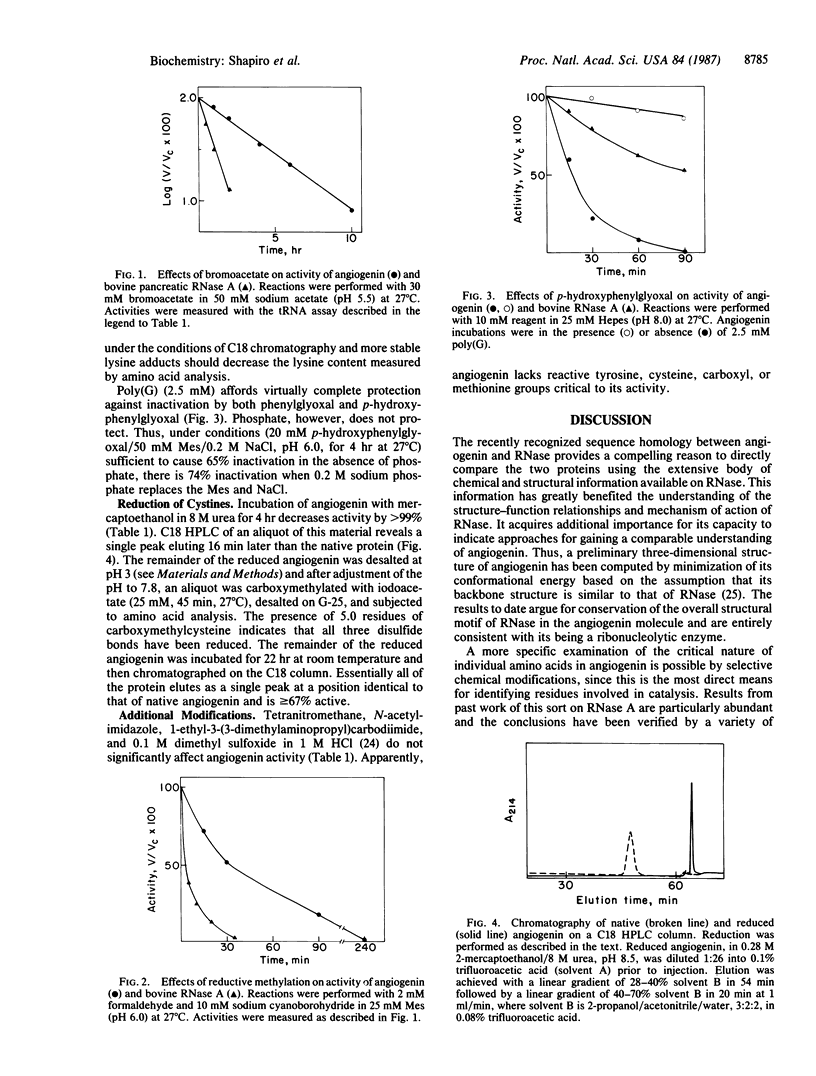
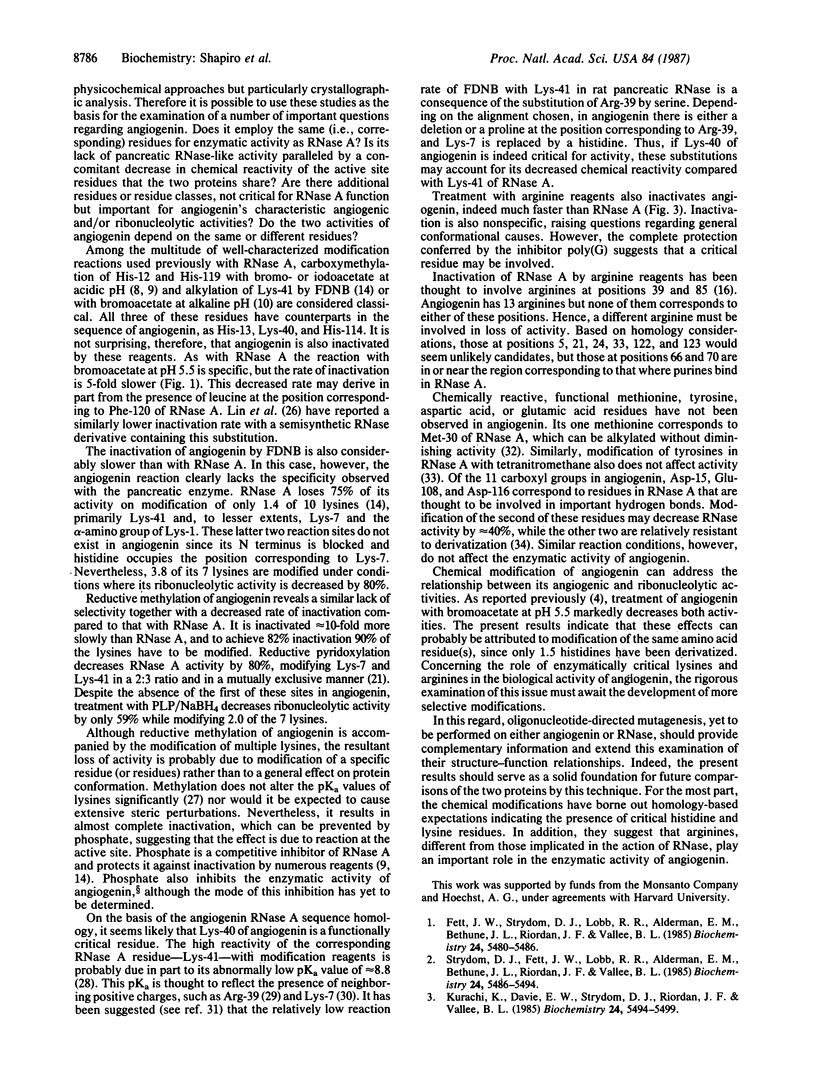
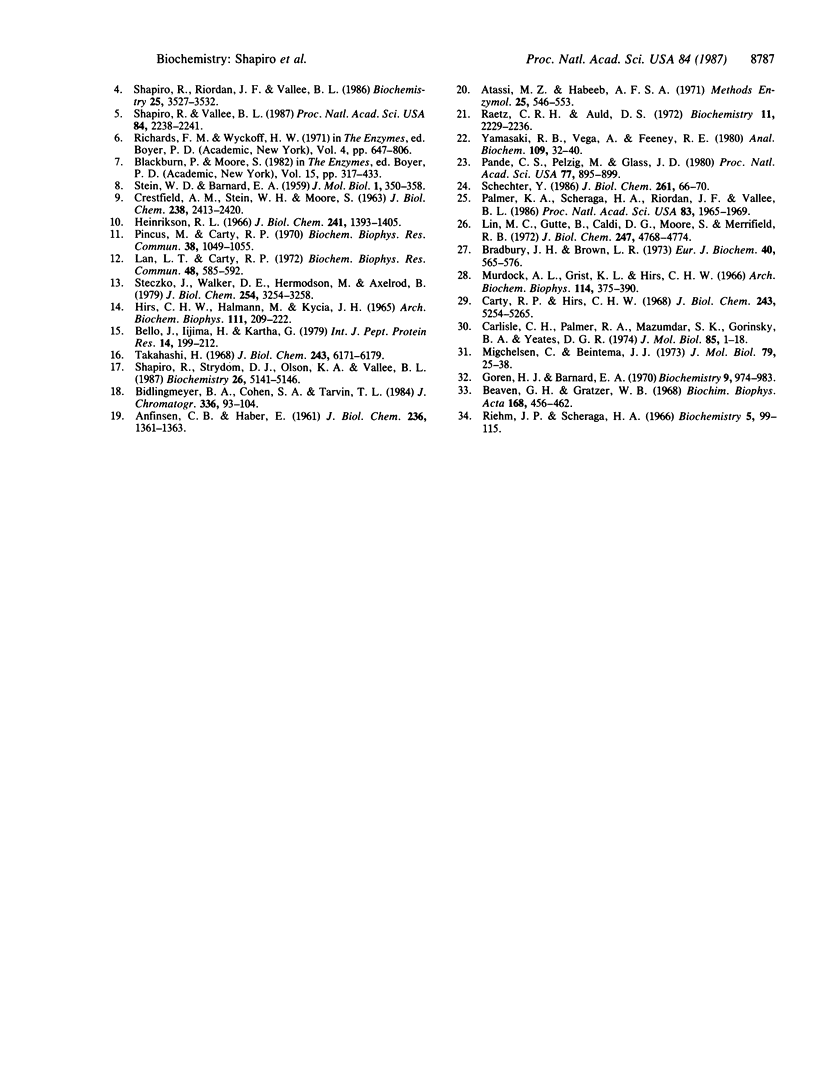
Selected References
These references are in PubMed. This may not be the complete list of references from this article.
- ANFINSEN C. B., HABER E. Studies on the reduction and re-formation of protein disulfide bonds. J Biol Chem. 1961 May;236:1361–1363. [PubMed] [Google Scholar]
- Beaven G. H., Gratzer W. B. Nitration of ribonuclease. Biochim Biophys Acta. 1968 Dec 3;168(3):456–462. doi: 10.1016/0005-2795(68)90179-7. [DOI] [PubMed] [Google Scholar]
- Bello J., Iijima H., Kartha G. A new arylating agent, 2-carboxy-4,6-dinitrochlorobenzene. Reaction with model compounds and bovine pancreatic ribonuclease. Int J Pept Protein Res. 1979;14(3):199–212. doi: 10.1111/j.1399-3011.1979.tb01926.x. [DOI] [PubMed] [Google Scholar]
- Bidlingmeyer B. A., Cohen S. A., Tarvin T. L. Rapid analysis of amino acids using pre-column derivatization. J Chromatogr. 1984 Dec 7;336(1):93–104. doi: 10.1016/s0378-4347(00)85133-6. [DOI] [PubMed] [Google Scholar]
- Bradbury J. H., Brown L. R. Determination of the dissociation constants of the lysine residues of lysozyme by proton-magnetic-resonance spectroscopy. Eur J Biochem. 1973 Dec 17;40(2):565–576. doi: 10.1111/j.1432-1033.1973.tb03228.x. [DOI] [PubMed] [Google Scholar]
- CRESTFIELD A. M., STEIN W. H., MOORE S. Alkylation and identification of the histidine residues at the active site of ribonuclease. J Biol Chem. 1963 Jul;238:2413–2419. [PubMed] [Google Scholar]
- Carlisle C. H., Palmer R. A., Mazumdar S. K., Gorinsky B. A., Yeates D. G. The structure of ribonuclease at 2-5 Angström resolution. J Mol Biol. 1974 May 5;85(1):1–18. doi: 10.1016/0022-2836(74)90125-9. [DOI] [PubMed] [Google Scholar]
- Carty R. P., Hirs C. H. Modification of bovine pancreatic ribonuclease A with 4-sulfonyloxy-2-nitrofluorobenzene. Effect of pH and temperature on the rate of reaction. J Biol Chem. 1968 Oct 25;243(20):5254–5265. [PubMed] [Google Scholar]
- Fett J. W., Strydom D. J., Lobb R. R., Alderman E. M., Bethune J. L., Riordan J. F., Vallee B. L. Isolation and characterization of angiogenin, an angiogenic protein from human carcinoma cells. Biochemistry. 1985 Sep 24;24(20):5480–5486. doi: 10.1021/bi00341a030. [DOI] [PubMed] [Google Scholar]
- Goren H. J., Barnard E. A. Relations of reactivity to structure in pancreatic ribonuclease. II. Positions of residues alkylated in certain conditions by bromoacetate. Biochemistry. 1970 Feb 17;9(4):974–983. doi: 10.1021/bi00806a037. [DOI] [PubMed] [Google Scholar]
- Heinrikson R. L. On the alkylation of amino acid residues at the active site of ribonuclease. J Biol Chem. 1966 Mar 25;241(6):1393–1405. [PubMed] [Google Scholar]
- Hirs C. H., Halmann M., Kycia J. H. Dinitrophenylation and inactivation of bovine pancreatic ribonuclease A. Arch Biochem Biophys. 1965 Jul;111(1):209–222. doi: 10.1016/0003-9861(65)90343-7. [DOI] [PubMed] [Google Scholar]
- Kurachi K., Davie E. W., Strydom D. J., Riordan J. F., Vallee B. L. Sequence of the cDNA and gene for angiogenin, a human angiogenesis factor. Biochemistry. 1985 Sep 24;24(20):5494–5499. doi: 10.1021/bi00341a032. [DOI] [PubMed] [Google Scholar]
- Lan L. T., Carty R. P. The synthesis of 2'-bromoacetamido-2'-deoxyuridine and its reaction with ribonuclease A. Biochem Biophys Res Commun. 1972 Aug 7;48(3):585–592. doi: 10.1016/0006-291x(72)90388-9. [DOI] [PubMed] [Google Scholar]
- Lin M. C., Gutte B., Caldi D. G., Moore S., Merrifield R. B. Reactivation of des (119-124) ribonuclease A by mixture with synthetic COOH-terminal peptides; the role of phenylalanine-120. J Biol Chem. 1972 Aug 10;247(15):4768–4774. [PubMed] [Google Scholar]
- Migchelsen C., Beintema J. J. Proton nuclear magnetic resonance studies of histidine residues in rat and other rodent pancreatic ribonucleases. Effects of pH and inhibitors. J Mol Biol. 1973 Sep 5;79(1):25–38. doi: 10.1016/0022-2836(73)90267-2. [DOI] [PubMed] [Google Scholar]
- Palmer K. A., Scheraga H. A., Riordan J. F., Vallee B. L. A preliminary three-dimensional structure of angiogenin. Proc Natl Acad Sci U S A. 1986 Apr;83(7):1965–1969. doi: 10.1073/pnas.83.7.1965. [DOI] [PMC free article] [PubMed] [Google Scholar]
- Pande C. S., Pelzig M., Glass J. D. Camphorquinone-10-sulfonic acid and derivatives: convenient reagents for reversible modification of arginine residues. Proc Natl Acad Sci U S A. 1980 Feb;77(2):895–899. doi: 10.1073/pnas.77.2.895. [DOI] [PMC free article] [PubMed] [Google Scholar]
- Pincus M., Carty R. P. The reaction of 2'(3')-O-bromoacetyluridine with ribonuclease A. Biochem Biophys Res Commun. 1970 Mar 27;38(6):1049–1055. doi: 10.1016/0006-291x(70)90345-1. [DOI] [PubMed] [Google Scholar]
- Raetz C. R., Auld D. S. Schiff bases of pyridoxal phosphate with active center lysines of ribonuclease A. Biochemistry. 1972 Jun 6;11(12):2229–2236. doi: 10.1021/bi00762a004. [DOI] [PubMed] [Google Scholar]
- Riehm J. P., Scheraga H. A. Structural studies of ribonuclease. XXI. The reaction between ribonuclease and a water-soluble carbodiimide. Biochemistry. 1966 Jan;5(1):99–115. doi: 10.1021/bi00865a014. [DOI] [PubMed] [Google Scholar]
- Shapiro R., Riordan J. F., Vallee B. L. Characteristic ribonucleolytic activity of human angiogenin. Biochemistry. 1986 Jun 17;25(12):3527–3532. doi: 10.1021/bi00360a008. [DOI] [PubMed] [Google Scholar]
- Shapiro R., Strydom D. J., Olson K. A., Vallee B. L. Isolation of angiogenin from normal human plasma. Biochemistry. 1987 Aug 11;26(16):5141–5146. doi: 10.1021/bi00390a037. [DOI] [PubMed] [Google Scholar]
- Shapiro R., Vallee B. L. Human placental ribonuclease inhibitor abolishes both angiogenic and ribonucleolytic activities of angiogenin. Proc Natl Acad Sci U S A. 1987 Apr;84(8):2238–2241. doi: 10.1073/pnas.84.8.2238. [DOI] [PMC free article] [PubMed] [Google Scholar]
- Shechter Y. Selective oxidation and reduction of methionine residues in peptides and proteins by oxygen exchange between sulfoxide and sulfide. J Biol Chem. 1986 Jan 5;261(1):66–70. [PubMed] [Google Scholar]
- Steczko J., Walker D. E., Hermodson M., Axelrod B. Identification of histidine-119 as the target in the site-specific inactivation of ribonuclease A by ferrate ion. J Biol Chem. 1979 May 10;254(9):3254–3258. [PubMed] [Google Scholar]
- Strydom D. J., Fett J. W., Lobb R. R., Alderman E. M., Bethune J. L., Riordan J. F., Vallee B. L. Amino acid sequence of human tumor derived angiogenin. Biochemistry. 1985 Sep 24;24(20):5486–5494. doi: 10.1021/bi00341a031. [DOI] [PubMed] [Google Scholar]
- Takahashi K. The reaction of phenylglyoxal with arginine residues in proteins. J Biol Chem. 1968 Dec 10;243(23):6171–6179. [PubMed] [Google Scholar]
- Yamasaki R. B., Vega A., Feeney R. E. Modification of available arginine residues in proteins by p-hydroxyphenylglyoxal. Anal Biochem. 1980 Nov 15;109(1):32–40. doi: 10.1016/0003-2697(80)90006-8. [DOI] [PubMed] [Google Scholar]


